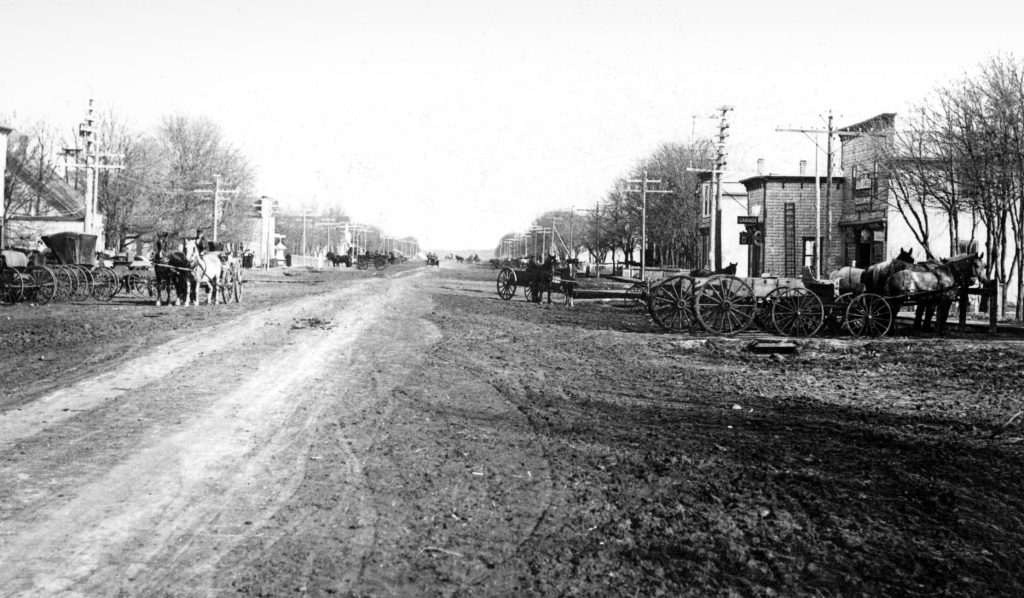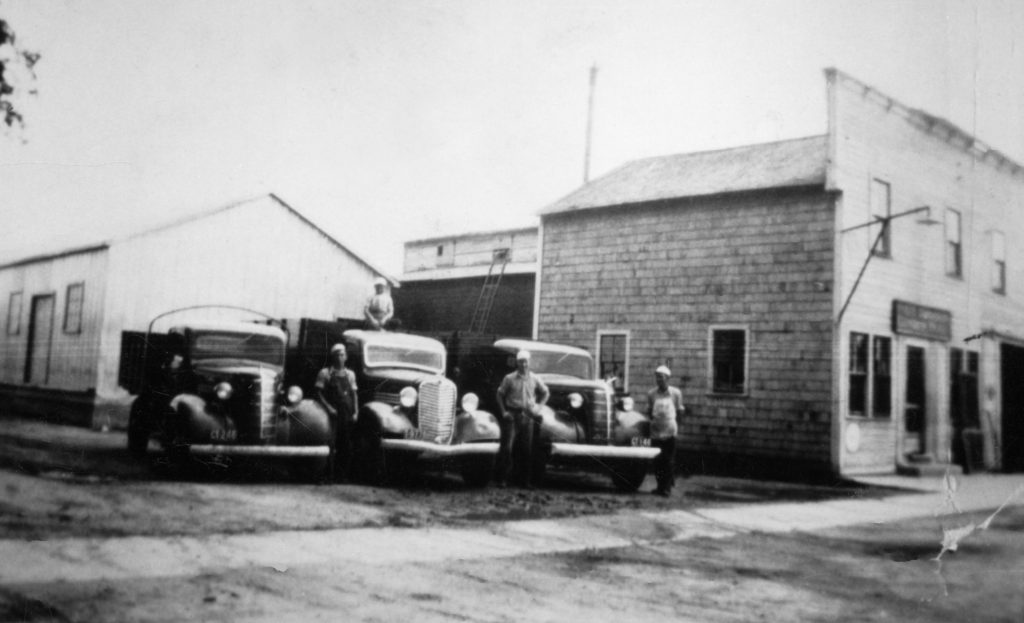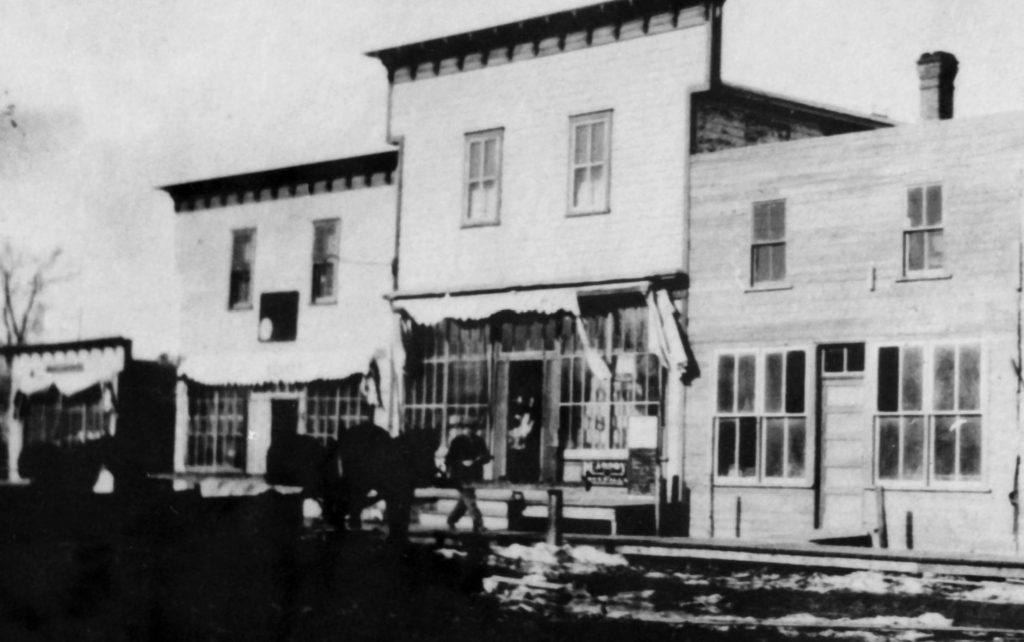The Railroad Passes by Steinbach
Ralph Friesen
Many of the original roads from Steinbach to the surrounding communities and to Winnipeg were little more than rutted trails, subject to being washed away in spring.1 It was unheard of for Canadian prairie communities to thrive, or even to exist, without a railroad to link them to larger centres. But Steinbach did thrive, responding to the lack of a railroad by developing a busy local transportation system. Merchants, lumbermen, farmers, machine dealers and others either took care of their own transporting or hired others to do it for them, using horse- or ox-drawn wagons or sleighs. Poorer individuals who could not afford wagons and were thus limited in their transportation options in summer, welcomed winter snows, as they could easily build sleighs out of poplar wood and thus move along the winter roads.2
Obstacles to winter travel could be considerable; in 1891 the correspondent to the Nordwesten described snow drifts as high as eight feet in some places following two days of storm.3The following year on January 22, 1892, the temperature dipped to 48 below, so that almost everyone was “looking for the comfortable spot behind the warm oven.”4 The northern lights put on spectacular displays against the backdrop of inky night skies above the snow-covered plains, a sight both inspiring and a little disquieting for the pioneers, one of whom reported that “a red band. . . appeared and then became one with a broad band running from east to west.”5
The Steinbach-Winnipeg journey became especially challenging during the late winter. At the end of March 1892, tanner Johann F. Toews made this trip with his brother-in-law Wilhelm Vogt. The two men made the usual stop at Ile des Chenes overnight on the way back, with snow falling. Starting out on the morning of the next day, they found that water had pooled everywhere and frozen, forming what Toews called “an inland sea.” Laboriously, they broke ice in front of their horses. At a bridge, Toews fell into the icy water while trying to fix a broken harness strap. He extricated himself and they continued, only to get the wagon stuck. Unhitching the horses, they rode on and stayed overnight again at a farmer’s house. The next morning they found that other travelers had broken trail through the ice before them, so they followed until they safely reached home at supper time.6

In 1886 a Winnipeg firm received a contract to build a road between La Broquerie and Steinbach, which brought increased traffic into Steinbach from the French community. Until this time, if the La Broquerie settlers wanted to get to Steinbach during the months that had no frost, and therefore no possibility of travelling by sleigh, they were obliged to go north, passing through Blumenhof, and then travel south to their destination.7
Some travellers were even more adventurous than Toews and Vogt: a young man named Cornelius Giesbrecht arrived in Steinbach in June 1901, having cycled from North Dakota. He reported the roads were “very bad.”8
Teamsters
From early days, an essential part of Steinbach’s transportation system was provided by men using sleighs and wagons, first drawn by oxen and later by horses. One of the first teamsters was pioneer Peter Toews of Wirtschaft 12. Another was farmer-teacher Gerhard E. Kornelsen, who frequently hauled goods to Niverville or Winnipeg for merchant Klaas Reimer. In January of 1885, for example, Kornelsen made a three-day run on sleigh, netting $1.60 from his $5 gross income, “which in the winter time is a good earning.”9
In 1893, produce farmer and butcher Johann R. Reimer of Wirtschaft 11 began a transport business to Winnipeg and the train station at Niverville, with a humble span of oxen. It would not be long before he had a team of horses pulling a covered wagon. He ran his transport business for K. Reimer & Sons for more than 25 years.10
Peter Dalke (1828–1909), who married into the Kornelsen family, was a resident in or near Steinbach for a number of years in the 1890s. Dalke, a drayman of freight and milk from nearby farmers, came to Manitoba from Nebraska after the death of his second wife in 1879. In 1901 he was hired by A. S. Friesen & Son to transport their locally manufactured straw blowers to Gretna.11
Heinrich E. Kornelsen of Friedensfeld, brother to Gerhard, supplemented his teacher’s income with a delivery service. His business, like that of the farmers, was subject to interruption by unfavourable weather: “Our express man, H. Kornelsen, is unable to transport sufficient quantities of lime and soda water because of the frequent rain and the bad roads,” remarked the Nordwesten correspondent in 1902.12A few years before Steinbachers might hardly even have known of the existence of soda water; now it was on offer—albeit not reliably—along with a growing variety of other consumer goods.
Heinrich Kornelsen was a big man with a legendary reputation for his physical strength. On one occasion a number of wagons, including Kornelsen’s, got stuck in a low spot on a muddy road outside Steinbach: “While others took the trouble to hitch several teams in front of one wagon in order to pull it out, Kornelsen just got off the wagon, put his back to the wheel, and with one tremendous heave, lifted the wagon out. He was overheard to remark, “No wonder the horses couldn’t move it. I found it hard myself.’13

For some years pioneer Johann S. Friesen, initially of Wirtschaft 4 and then of Hochstadt, held the mail transportation contract from Grunthal to Hochstadt, using a donkey and buggy before the regular rural mail route was inaugurated. Äsel Fries’e, as he was known because he kept donkeys, stuck to this mode of transportation long after horses had become the norm.
Railway Petition
The dream of a railroad for Steinbach, despite opposition, was powerful and persistent in the minds of some boosters. In the summer of 1879 the so-called “Emerson Section” of the St. Paul, Minneapolis and Manitoba Railway was completed between Winnipeg and Emerson, through Niverville, 40 kilometres west of Steinbach. As Niverville was closer than Winnipeg, it served as an alternative shipping and receiving destination for some of Steinbach’s commerce, including trade with the United States. Still, it was impractically distant. When the Canadian Pacific Railway line across Canada was completed in late 1885, rail transportation became even more important interprovincially and internationally.
In 1892 the South-Eastern Railway Co. proposed to build a new rail line, prompting some Steinbach citizens to initiate a petition in favour of bringing the line through the community. Their “strong petition,” signed by “the people of Steinbach,” rhapsodized about “a number of excellent places of business.” These businesses needed a reliable link to Winnipeg, “which . . . can only be reached by several days’ [of] laborious and expensive traveling.” The petition boldly claimed that “the surrounding district could easily accommodate ten times the number of settlers now in it.” Nothing came of the petition, which in itself would very likely have been the cause of controversy in Steinbach, where traditionalists were anxious to maintain the difficult access to the secular city that the petitioners wished to overcome.14
Six years later another proponent let it be known that a railway might be built in a south-easterly direction from Winnipeg. The Nordwesten correspondent stated that he had heard talk in Winnipeg to the effect that the East Reserve Mennonites did not want the railroad, but according to him “most would be very happy to be able to deliver their wheat here, instead of incurring the costs of transportation to Winnipeg.” A railroad going through the middle of Range 9, Township 3 beyond the Rat River would be preferred, according to the correspondent, as that route would facilitate the best transportation for grain and wood.15
As it turned out, the Manitoba and South Eastern Railroad Company did start laying tracks—at Giroux, about seven miles northeast of Steinbach. In October, 1898 the flour mill manager, Johann I. Friesen, who had had a high vantage point on the roof of the mill, reported that he had already “seen the smoke of the working locomotive,” while others said they heard the sound of spikes being pounded in.16
The Manitoba and South Eastern Railway was a branch line which was soon consolidated into the much larger entity known as the Canadian Northern Railway, linking the prairies with shipping routes on Lake Superior. In July 1900, a large picnic was held in Warroad, Minnesota, in celebration of the CNR’s completion. An expedition of locals took advantage of reduced fares and went to the picnic. Some got more than they bargained for. Three Steinbach fishermen set out on their boat on the waters of Lake of the Woods. The choppy water made the going a little precarious, so one of the three was told that he should lie down on the bottom of the boat, for stability. He soon lost patience with this humble posture, sat up, and dumped himself and his fellows into the water, necessitating a rescue operation. One of the three, the merchant Johann Esau, was not much of a swimmer and barely reached shore. To add insult to ignominy, he was charged 15 cents for the rescue operation.17
Even after it was clear that the South Eastern line was going through Giroux, talk of still another railroad to come through Steinbach persisted, generating a strong demand for land. In the spring of 1899 the Nordwesten correspondent commented that the buying and selling of real estate was marked almost by “a kind of joy.”18At the administrative centre of the real estate transactions was A. S. Friesen, who had become a notary public in 1891, enabling him to attest to the authenticity of deeds and take affidavits. He conducted almost all of the land transactions in the Steinbach district for more than two decades, as many as 75 in a year. For the most part he charged $3 for registering deeds and transfers with the Land Titles Office, while the occasional letter of administration cost $10 or $13.19

“Steinbach Station,” as it was called, was built in Giroux, not Steinbach, even though as many as 13 sleighs in a caravan might travel between Steinbach and Winnipeg carrying grain or transporting goods. Trips to Winnipeg were becoming commonplace, and the teamsters made frequent use of a livery barn on Elgin (then Jemima Avenue), run by a man named Bill Crawford, to unhitch their oxen or horses.20
At first Giroux showed signs of flourishing and some Steinbach Mennonites opened commercial enterprises there. Aganetha and Abram W. Reimer sold their holdings in Steinbach in 1908 and built a “travellers’ home” in Giroux, where Aganetha served meals to the train crews. The Reimers also opened an abattoir and general store under the rubric Reimer Trading Company. Yet most Steinbachers, already landowners rooted in their village, would not move existing businesses. Instead “Steinbach Station” created a new route for the village’s teamsters. Johann W. Reimer, son of merchant Klaas Reimer, started a transport service between the Giroux railroad station and Steinbach which was to last 25 years, beginning with oxen but graduating to horses, of which he had 17 head on his farm at one point. His rate was $1.25 per load.21 Gerhard F. Friesen, a “Texas” nephew of postmaster A. S. Friesen, took the contract for transporting mail from the Giroux station to Steinbach, effective October 1, 1900.22
When Peter (Schmett) Toews left Steinbach in 1907, Klaas I. Friesen, brother to miller Johann I. Friesen, moved from the Greenland settlement north of Blumenort onto Toews’ old lot (originally Wirtschaft 8), where he operated a cartage business also running goods from the Giroux railway station to Steinbach. Friesen took over the operation of Toews’ lodging house, known as “the Stopping Place,” and ran the adjoining livery barn until 1920.23
- Adapted and re-printed with permission from Ralph Friesen, Between Earth and Sky: Steinbach, The First Fifty Years (Steinbach, MB: Derksen Printers, 2009), 292–299. ↩︎
- Rundschau, November 25, 1896. ↩︎
- Nordwesten, December 18, 1891. ↩︎
- Nordwesten, January 22, 1892. ↩︎
- Nordwesten, February 26, 1892. ↩︎
- Nordwesten, April 15, 1892. ↩︎
- K. J. B. Reimer, “Historical Sketches,” Carillon News, 1952. ↩︎
- Nordwesten, June 19, 1901. ↩︎
- Quoted in Royden Loewen, Family, Church, and Market: A Mennonite Community in the Old and New Worlds, 1850–1930 (Toronto: University of Toronto Press, 1993), 157. ↩︎
- Die Steinbach Post [hereafter SP], April 6, 1965. ↩︎
- Delbert F. Plett, Dynasties of the Mennonite Kleine Gemeinde in Imperial Russia and North America (Steinbach, MB: Crossway Publications, 2000), 81; Nordwesten, February 14, 1901. ↩︎
- Nordwesten, June 19, 1902. ↩︎
- Carillon News, Sept. 16, 1960. ↩︎
- Manitoba and South-Eastern Railway Co.: Summary of petitions along the line of the M & SE Ry., 1892, Manitoba Archives. ↩︎
- Nordwesten, June 16, 1898 and June 30, 1898. ↩︎
- Nordwesten, October 20, 1898. ↩︎
- Nordwesten, July 26, 1900. ↩︎
- Nordwesten, March 9, 1899. ↩︎
- Gerhard G. Kornelsen, in Delbert F. Plett, Pioneers and Pilgrims: The Mennonite Kleine Gemeinde in Manitoba, Nebraska and Kansas, 1874 to 1882 (Steinbach, MB: Crossway Publications, 1990), 257. A paragraph in the Steinbach Post, undated, refers to Friesen as “a notary public and agent in complicated legal issues.” ↩︎
- SP, July 30, 1941. ↩︎
- K. J. B. Reimer, “Historical Sketches of Steinbach,” Carillon News, 1952; Levina Reimer and Delbert Plett, “Aganetha Barkman Reimer,” Preservings 17 (Dec 2000): 104. ↩︎
- Nordwesten, September 20, 1900. ↩︎
- Die Mennonitische Rundschau, September 18, 1907; Nordwesten, September 18, 1907; SP, April 20, 1965; Delbert F. Plett, “From Steinbach to Flanders Field,” Preservings 13 (Dec 1998): 49. ↩︎
